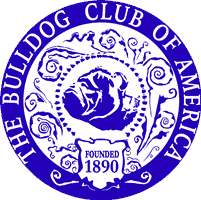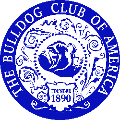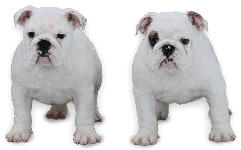"The nose should be large, broad and black, its tip set back deeply between the eyes. The distance from bottom of stop, between the eyes, to the tip of nose should be as short as possible and not exceed the length from the tip of nose to the edge of underlip. The nostrils should be wide, large and black, with a well-defined line between them. Any nose other than black is objectionable and a brown or liver-colored nose shall disqualify."
Bulldogs belong to a group of dogs know as "brachiocephalic" breeds or "short-nosed" breeds. Since dogs do not sweat to cool themselves as people do they rely on panting to help expel excess heat. The short nosed breeds cooling mechanism and air transfer is much less than other breeds. Being aware that your Bulldog needs attention to avoid overheating is an important role for you as owner.
Many Bulldogs are relatively heat tolerant. They are smart animals who generally will temper their activity level to the weather. Bulldogs have been known to choose to lie outside in 95 degree heat without problems, even choosing it over air-conditioned space inside. However, their care is your responsibility, so you should be vigilant when your dogs are outside in the heat and make sure they do not get overheated.
If your dog is overheated and/or over excited, it is critical to calm him down, since this can raise the body temperature like a fever does. You should make sure the throat is free of mucous, and minimize the swelling due to heat. Fast action is essential and you generally will not have a real problem if you act quickly rather then letting problems build. It is better to err on the side of caution with these situations: you won't harm the dog with water and ice, but overheating can debilitate and even kill any animal, even humans.
If your dog has a problem, you can clear the dog's throat of mucous with your finger. A squirt of lemon juice will cut through any mucous and clear the throat. Some dogs like the taste of lemon; many hate it. Then give him ice cubes and hold his mouth shut to make him chew them if necessary. Get him to a spot where he can lie calmly out of the heat.
Don't leave your dog outside in the hot sun unsupervised. Don't have him sit around on a leash without access to water while you're socializing if it's warm. Never leave any dog in an enclosed car in the summer - cars turn into ovens really easily in hot weather
You should become aware of the sound and rhythm of the dog's normal breathing and panting. If your dog is over-excited, his breathing will be abnormally fast and hard. If the dog is hyperventilating, his tongue will have a bluish cast instead of the normal pink and it will hang out unusually far. His panting will be heavy, probably with a rasping sound and he may look wild eyed. To treat him, you will need to use some or all of the following: water, ice, lemon juice, and aspirin suppositories.
You can immediately place him in a tub of cold (but not ice) water or in a cold shower. If you're outside, pour water over him - straight from a garden hose if possible. He may not like it, but do it anyway. It's important to get him wet down to the skin so evaporation of the water can speed bodily cooling. Then get him into the shade. You can clear then his throat with lemon juice. Give him ice cubes and hold a compress of ice cubes on his genitals and/or head. If his temperature is high (a dog's normal temperature is about 102 degrees), give him an aspirin suppository.
Breathing problems can start where the air first comes in - at the nostrils. The Bulldog standard calls for wide nostrils to maximize the airflow and a well-bred Bulldog should have large, well-opened nostrils. However, nostrils of Bulldogs come in a variety of sizes, and narrow nostrils can cause problems. In that case, the nasal cartilage can restrict airflow. Fortunately, this is not usually a problem. Nostrils can be surgically enlarged to increase air flow, but it is infrequent that it is necessary. If not corrected, especially is there are other respiratory issues present, narrow nostrils can lead to problems breathing, especially when the dog is active.
The next potential point for blockage of airflow is the soft palate. The front part of the roof of the mouth is the hard palate and the rear, up until the windpipe, is the soft palate. When the soft palate is elongated, as it may be in brachiocephalic dogs, it can partially block the airway when the animal breathes. Treatment will depend on the amount of tissue, its location and the dog's temperament. A calm dog, with a slight elongation of the soft palate may need nothing more than extra attention during hot weather (when throats tend to swell).
By the age of four or five months, the Vet should be able to tell you if the soft palate is elongated. If he doesn't have it by that age, he won't suddenly develop it later in life. If it is elongated, by 6-8 months of age you'll know about how long it will be and whether it's a problem depending on your dog's activity level and your lifestyle. The soft palate can be surgically shortened if it causes serious problems, especially if the animal is excitable. This is because an excitable animal will breathe and pant harder, which causes swelling of the throat, which is already partially blocked by the soft palate.
Where surgery is indicated, it will generally be performed after the puppy has reached full growth - after 10-12 months. You must wait this long for two reasons. First to determine whether this is a real problem - you don't want your dog to have unnecessary surgery. Second, if done much earlier, it's harder to predict the final head size and the Vet may take off too much or too little.
Reputable breeders have made significant improvements in the frequency of palate issues. Fifteen years ago, it would be difficult to talk ringside at a dog show because of the noise made by the breathing of the dogs. Today, the incidence of palate problems has been reduced by breeders paying attention to the issue in their breedings. This along is a good reason to get a puppy from a member of BCAs Breeder Referral Program.
Yes, your dog has tonsils just like you do and they are subject to the same potential problems. Some dogs never have problems; some get tonsillitis and, if antibiotics don't work, have their tonsils taken out because of infection. Tonsils which are too large can be removed - it's a relatively minor operation, just like with children. The dog usually can be home the same day and won't spend more than a night with the Vet.
The size of the trachea (windpipe) also varies among dogs. While a large windpipe makes breathing easier, dogs can do quite well with narrower openings. Bulldog windpipes are generally smaller compared to the size of the dog than in other breeds. The size of the windpipe cannot be corrected surgically. This is another area where BCA breeders have focused their attention.
As long as the windpipe is big enough for the dog to live a good life, it's not a big issue for you. For the Vet, the issue will center on the best way to anesthetize the dog if surgery is required for some other condition. You can discuss this with your Vet.
Bulldogs have relatively narrow windpipes for their size. The unusual construction of their nasal passages and soft palates, coupled with the narrower trachea, makes them exceptionally vulnerable to breathing problems in the heat. Over excitement, and the resulting hyperventilation, causes similar problems. This can result from swelling of the soft palate tissue, poor tissue tone, or too long a soft palate, each of which can block off the windpipe. In addition, prolonged problem breathing can cause eversion of the laryngeal saccules, causing them to close over the windpipe during breathing.
This is a frightening, but harmless, condition seen fairly frequently in Bulldogs. When this happens, the dog pulls air into the nose fiercely, producing an incredible racket. It seems as though he was trying to clear his nasal passages. After the first few times, you will get used to this. The dog is entirely normal afterwards and no treatment is needed.
Just like people, dogs can develop allergies. If the dog breaks out in welts or looks as though he has hives he is probably having an allergic reaction. Take him to the Vet without delay. He'll probably get shots to alleviate the problem. Then you have to identify the cause. Common causes are flea bites (some dogs are allergic to fleas) or a contact allergy. As a precaution, you can have your house sprayed for fleas twice a year by a professional. It doesn't cost much and provides a long lasting remedy for a potentially unpleasant problem. If you keep the flea population under control, you should reduce the chance of allergic reactions.
Some dogs are allergic to chemicals used to clean rugs or floors. Dogs have been known to be allergic to a supermarket brand of rug cleaner, so be careful of such things. Of course, dogs may chase chase wasps or bees, whose stings can cause an allergic reaction, so you can never be sure. If he is allergic, you have to be especially careful, since an allergic attack sometimes produces respiratory problems. If allergies are identified, it would be good to have your Vet recommend medications to treat an acute allergic attack.












